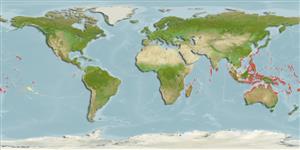Actinopterygii (ray-finned fishes) >
Perciformes (Perch-likes) >
Pomacentridae (Damselfishes) > Pomacentrinae
Etymology: Chrysiptera: Greek, chrysos = golden + Greek, pteron = fin, wing (Ref. 45335).
Environment / Climate / Range
Ecology
Marine; reef-associated; non-migratory; depth range 0 - 3 m (Ref. 30874). Tropical, preferred ?; 30°N - 28°S
Indo-Pacific: East Africa to the Line and Pitcairn islands, north to Japan, south to Australia.
Size / Weight / Age
Maturity: Lm ? range ? - ? cm
Max length : 11.5 cm TL male/unsexed; (Ref. 90102)
Adults occur among rubble or consolidated reef rock of exposed intertidal reef flats and sandy beaches, subject to mild surge. Also near freshwater run-offs (Ref. 48636). They occur in small groups. Feed mainly on benthic algae. Oviparous, distinct pairing during breeding (Ref. 205). Eggs are demersal and adhere to the substrate (Ref. 205). Males guard and aerate the eggs (Ref. 205).
Life cycle and mating behavior
Maturity | Reproduction | Spawning | Eggs | Fecundity | Larvae
Oviparous, distinct pairing during breeding (Ref. 205). Eggs are demersal and adhere to the substrate (Ref. 205). Males guard and aerate the eggs (Ref. 205).
Allen, G.R., 1991. Damselfishes of the world. Mergus Publishers, Melle, Germany. 271 p. (Ref. 7247)
IUCN Red List Status (Ref. 115185)
CITES (Ref. 94142)
Not Evaluated
Threat to humans
Harmless
Human uses
Fisheries: minor commercial
More information
ReferencesAquacultureAquaculture profileStrainsGeneticsAllele frequenciesHeritabilityDiseasesProcessingMass conversion
Tools
Special reports
Download XML
Internet sources
Estimates of some properties based on models
Phylogenetic diversity index (Ref.
82805): PD
50 = 0.5000 [Uniqueness, from 0.5 = low to 2.0 = high].
Trophic Level (Ref.
69278): 2.4 ±0.3 se; Based on diet studies.
Resilience (Ref.
69278): High, minimum population doubling time less than 15 months (K=0.8).
Vulnerability (Ref.
59153): Low vulnerability (17 of 100) .
